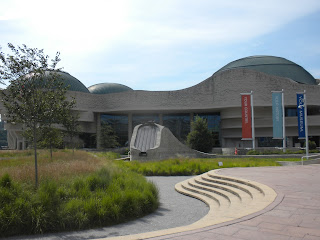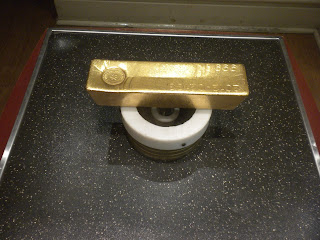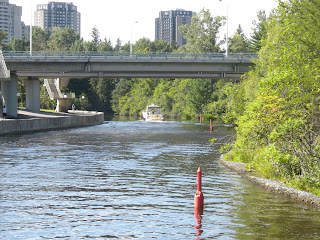July 30: Hull and Ottawa.
The Rideau River spilling into the Ottawa River.
The Captain performing galley duty.
A diminutive Captain standing next to a statue of Maurice "The Rocket" Richard. Canadians love their hockey and Maurice Richard in particular. He was known for his speed on the ice and his powerful shots. During his long 18 year career, he played for the Montreal Canadiens and was the first player to score 50 goals in 50 games.
The Canadian Parliament seen from across the river at Hull.
Ottawa Staircase Locks. This is a set of 8 locks that raises boats from the Ottawa River to the beginning of the Rideau Canal. Once the first lock is entered, boats must continue up through the next 7 locks as one lock empties into the next one. Today, we were just scouting out what lies ahead of us.
With more than 3.75 million pieces, the museum has the country's most impressive collection of artifacts of human history.
A large wing of the museum is devoted to art and artifacts from the native peoples who are called the "First Nations". "Within Canada, "First Nations" (most often used in the plural) has come into general use-replacing the deprecated term "Indians"-for the indigenous peoples of the Americas." Wikipedia.
Impressive collection of totem poles
decorative plates
and many masks.
The next day the sun came out and the boat in front of us left giving us more space and access to power. Here is the Duddon Pilot on the canal wall in downtown Ottawa. It is not often that boaters can dock right in the middle of a large city. Our Canadian mooring and locking pass enables us to stay on the canal wall with only a $10 fee per night for electricity. A great deal!
The next few days were spent playing tourist. A visit to the Canadian Parliament is a must. Seen here from where our boat is docked.
In 1841, Lower Canada (now Quebec) joined with Upper Canada (now Ontario) to from the Province of Canada. For many years, the seat of government alternated from Montreal to Quebec City to Kingston none of which proved desirable for a variety of reasons. Then in 1857, Queen Victoria was asked to choose a permanent capital. Surprisingly, the Queen choose the rough and ready lumber town of Ottawa. Not only was Ottawa a good political compromise, it also lay a more secure distance from the American border. After the war of 1812, Canadians became concerned about a potential invasion from the South. (Per Parks Canada)
Free English and French tours are offered of the Parliament building. The following photographs do not do it justice. We had a terrific student guide who covered the history and architectural details of the building.
The House of Commons.
Library of Parliament a showpiece of High Victorian Gothic Revival. Its floor features a beautiful pattern of cherry, oak and walnut. Hundreds of flowers, masks and mythical creatures are carved in the paneling of white pine. In the center of the circular domed room stands a white marble statue of the young Queen Victoria.

The Changing of the Guards occurs every day at 10:00 a.m. Patterned after the tradition at Buckingham Palace, it is quite a show with Scottish bagpipes, a band and the guards in their resplendent red coats.
We purchased a 3 day bus pass that allowed us to hop on and hop off the double decker bus at various stops throughout the city. Like any major city, Ottawa has its fair share of museums and we took in a few.

One of the first stops was the War Museum which housed a large number of WWII tanks, armaments and historical narratives from the various wars that Canadians have been involved in ranging from the Indian Wars, to the Boer War to more recently in Afghanistan.
From a captured T-34 Russian tank
The city abound with sculptures. The Captain is seen here with the "Dancing Bear."
And the Admiral with Oscar Peterson, a Canadian musician, who was ranked as one of the world's greatest jazz virtuosos.
The Canadians very proudly and prominently honor their war dead. There are many statues and memorials to remind people of their sacrifices for freedom. Here Canadian military personnel stand guard at the tomb of the "Unknown Soldier."
We paid a visit to the Canadian Mint which included an interesting narrative on how their gold and silver coins are minted. Below a gold bar only available for viewing!
Negotiating the narrow channel outside Ottawa.
One of the 6 locks on our journey today.
decorative plates
and many masks.
July 31: Up the staircase of locks to downtown Ottawa. As the entire process of ascending the stairs takes over 3 hours, we were advised to proceed to the blue line at the bottom of the locks to ensure that we would be in the first batch of boats to lock up. The blue line is a painted line at the entrance to all locks. By tying up at the blue line, boaters indicate their intention to lock through to the lock master. Even arriving at the blue line by 8:00 a.m., we were the third boat in line. The locks do not operate until 9:00 a.m. so we had a cup of coffee and waited. We were concerned that other boats would arrive later and jump ahead of us into the lock. Not to worry though, as on the dot of nine o'clock, the lock master decided that as the largest boat in the group that we should proceed first into the lock.
A good thing that we had our foul weather jackets handy as the rain came down in buckets. Here is the poor Captain holding onto the stern line as we endured the torrential downpour. It did not let up once during the 3 hour endurance test of locking through 8 locks. We were some seriously wet puppies by the time we reached the top of the staircase. Even the usual crowd of tourists that gather to watch the boats locking through were absent. Smart enough to seek shelter from the rain, eh?
Looking back down the staircase. After the last lock, a decidedly tired and wet crew pulled into the first available slot on the canal wall. The canal wall was almost completely full and we were lucky to get a place. It was not the greatest spot but we hoped the small boat in front of us would leave in the next day or so and give us both more space and access to power.
Once the rain stopped, we took off to spoil ourselves with some local treats-almond croissants and coffee. Yummy! The Byward Market is in the oldest surviving part of Ottawa and is a food lover's delight with fruit and vegetable stalls, cheese and meat shops and every imaginable type of small restaurant.
August 1-6: Enjoying the Capital City.
The next day the sun came out and the boat in front of us left giving us more space and access to power. Here is the Duddon Pilot on the canal wall in downtown Ottawa. It is not often that boaters can dock right in the middle of a large city. Our Canadian mooring and locking pass enables us to stay on the canal wall with only a $10 fee per night for electricity. A great deal!
The next few days were spent playing tourist. A visit to the Canadian Parliament is a must. Seen here from where our boat is docked.
Free English and French tours are offered of the Parliament building. The following photographs do not do it justice. We had a terrific student guide who covered the history and architectural details of the building.
The House of Commons.
Library of Parliament a showpiece of High Victorian Gothic Revival. Its floor features a beautiful pattern of cherry, oak and walnut. Hundreds of flowers, masks and mythical creatures are carved in the paneling of white pine. In the center of the circular domed room stands a white marble statue of the young Queen Victoria.

The Changing of the Guards occurs every day at 10:00 a.m. Patterned after the tradition at Buckingham Palace, it is quite a show with Scottish bagpipes, a band and the guards in their resplendent red coats.
We purchased a 3 day bus pass that allowed us to hop on and hop off the double decker bus at various stops throughout the city. Like any major city, Ottawa has its fair share of museums and we took in a few.

One of the first stops was the War Museum which housed a large number of WWII tanks, armaments and historical narratives from the various wars that Canadians have been involved in ranging from the Indian Wars, to the Boer War to more recently in Afghanistan.
From a captured T-34 Russian tank
The city abound with sculptures. The Captain is seen here with the "Dancing Bear."
And the Admiral with Oscar Peterson, a Canadian musician, who was ranked as one of the world's greatest jazz virtuosos.
The Canadians very proudly and prominently honor their war dead. There are many statues and memorials to remind people of their sacrifices for freedom. Here Canadian military personnel stand guard at the tomb of the "Unknown Soldier."
We paid a visit to the Canadian Mint which included an interesting narrative on how their gold and silver coins are minted. Below a gold bar only available for viewing!
August 6: Leaving Ottawa. Our time in Ottawa finally drew to a close and we left to travel the Rideau Canal. The canal is very narrow at this point and we have a number of low bridges and locks to contend with as we head to our ultimate destination which is Kingston. Today, however, we are only going 23 miles to Hurst Marina but we have 6 locks and 3 swing bridges to deal with.
One of the 6 locks on our journey today.

































No comments:
Post a Comment